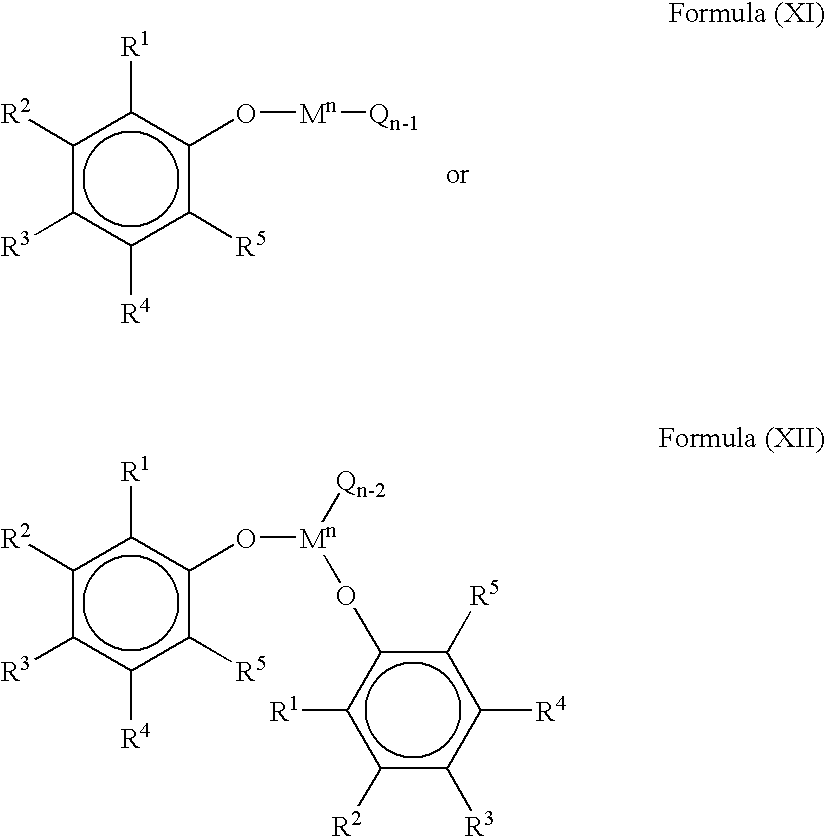Polymerization catalyst activators, method of preparing, and their use in polymerization processes
a technology of activators and catalysts, applied in catalyst activation/preparation, chemical/physical processes, group 3/13 element organic compounds, etc., can solve the problems of low activity of metallocene catalysts, high cost of utilization, and unstable mao
- Summary
- Abstract
- Description
- Claims
- Application Information
AI Technical Summary
Benefits of technology
Problems solved by technology
Method used
Image
Examples
example 2
0.07 grams of triethylaluminum in toluene were combined with 1.0 grams of silica (Davison 948 calcined at 600° C., 2 wt %F) in a 100 flask. The resulting slurry was allowed to sit overnight. The silica was then filtered, and rinsed with several 10 ml portions of toluene. 0.10 grams of 4,5,6,7-tetrafluoroindole was added to the silica, slurried in toluene and heated to 100° C. for 1.5 hours. The silica was then filtered, rinsed with several 10 ml portions of toluene, and subsequently combined with 0.09 grams of a 20 wt % solution of (1,3-Me,BuCp)2ZrMe2 in toluene. The supported catalyst was allowed to sit at room temperature for 1 hr. The catalyst was filtered, rinsed with several 10 ml portions of toluene, and dried under a vacuum.
example 3
0.08 grams of triethylaluminum in toluene were combined with 1.0 grams of silica (Davison 948 calcined at 200° C.) in a 100 flask. The resulting slurry was allowed to sit overnight. The silica was then filtered, and rinsed with several 10 ml portions of toluene. 0.10 grams of 4,5,6,7-tetrafluoroindole was added to silica, slurried in toluene and heated to 100° C. for 1.5 hours. The silica was then filtered, rinsed with several 10 ml portions of toluene, and subsequently combined with 0.09 grams of a 20 wt % solution of (1,3-Me,BuCp)2ZrMe2 in toluene. The supported catalyst was allowed to sit at room temperature for 1 hr. The catalyst was filtered, rinsed with several 10 ml portions of toluene, and dried under a vacuum.
example 4
0.08 grams of triethylaluminum in toluene were combined with 1.0 grams of silica (Davison 948 calcined at 200° C.) in a 100 flask. The resulting slurry was allowed to sit overnight. The resulting silica was filtered, and rinsed with several 10 ml portions of toluene. 0.090 grams of 4,5,6,7-tetrafluoroindole was added to silica, slurried in o-xylene and heated to 140° C. for 1.5 hours. The silica was then filtered, rinsed with several 10 ml portions of toluene, and subsequently combined with 0.09 grams of a 20 wt % solution of (1,3-Me,BuCp)2ZrMe2 in toluene. The supported catalyst was allowed to sit at room temperature for 1 hr. The catalyst was filtered, rinsed with several 10 ml portions of toluene, and dried under a vacuum.
PUM
| Property | Measurement | Unit |
|---|---|---|
| Temperature | aaaaa | aaaaa |
| Temperature | aaaaa | aaaaa |
| Pressure | aaaaa | aaaaa |
Abstract
Description
Claims
Application Information
 Login to View More
Login to View More - R&D
- Intellectual Property
- Life Sciences
- Materials
- Tech Scout
- Unparalleled Data Quality
- Higher Quality Content
- 60% Fewer Hallucinations
Browse by: Latest US Patents, China's latest patents, Technical Efficacy Thesaurus, Application Domain, Technology Topic, Popular Technical Reports.
© 2025 PatSnap. All rights reserved.Legal|Privacy policy|Modern Slavery Act Transparency Statement|Sitemap|About US| Contact US: help@patsnap.com



